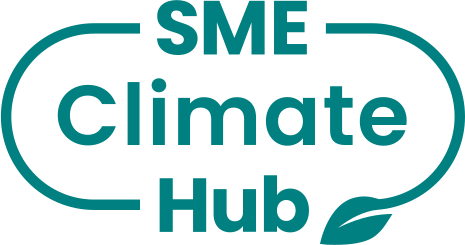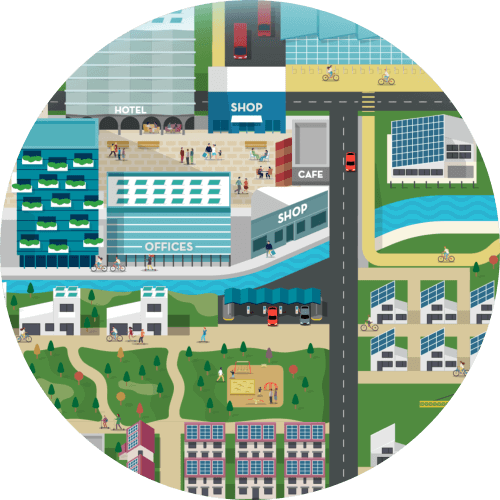Découvrez les étapes que votre entreprise peut suivre vers un avenir plus durable grâce à nos ressources gratuites.
The Change CollectiveRapport sur le climat
Introduction *
Commitment And Targets *
Own emissions *
Value chain emissions *
(optional)Actions and plans to reduce emissions *
Climate Solutions *
(optional)Management and strategy *
(optional)Results, challenges and outlook *
Introduction *
reporting year
*2021
number of employees in the reporting year
*9
Commitment And Targets *
net zero target year
*2025
Base year
*2019
comment on your net zero targets
*Our ambition target year was 2030. We have lowered this to 2025 because we see that it's realistic to compensate for our scope 3 emissions by 2025 or earlier.
near-term scope 1 target
*100
target year
*2025
near-term scope 2 target
*100
target year
*2025
near-term scope 3 target
*-
target year
*2025
comment on your near-term targets
*We focused on our direct scope 1 & 2 emissions first. From 2023 onwards, we are able to offset our total emissions in scope 1, 2 & 3 and therefore reach net zero.
Own emissions *
scope 1 emissions
scope 1 emissions (metric tons co2e)
*-
own facilities
*N/A
own vehicles
*N/A
own processes
*N/A
scope 2 emissions
scope 2 emissions (metric tons co2e)
*2.8
total energy consumption (kwh)
*2974
renewable energy
*100
purchased electricity
*1.65
metric tons CO2eRenewable electricity (%)
100
purchased steam
*N/A
Renewable electricity (%)
-
purchased heating
*1.15
metric tons CO2eRenewable electricity (%)
-
purchased cooling
*N/A
Renewable electricity (%)
-
Comment on your energy consumption
*Our energy consumption comes from 100% renewable energy sources, of which 85% comes from solar power. Additionally, we use solar panels that generated an additional 700 KWH.
Value chain emissions (optional) *
scope 3 emissions
scope 3 emissions (metric tons co2e)
*3.98
supply chain related - upstream emissions
purchased goods and services
*Not measured
capital goods
*Not measured
fuel and energy related activities
*N/A
transportation and distribution (upstream)
*N/A
waste in operations
*N/A
business travel
*2.03
metric tons CO2eemployee commuting
*1.95
metric tons CO2eleased assets (upstream)
*N/A
customer related - downstream emissions
transportation and distribution (downstream)
*N/A
processing of sold products
*N/A
use of sold products
*N/A
end-of-life treatment of products
*N/A
leased assets (downstream)
*N/A
franchises
*N/A
investments
*N/A
List any sources of emissions excluded:
*Purchased goods and services: groceries, hardware, office supplies, furniture and decor, business services and utilities (banking, insurance, digital services), and miscellaneous (gifts, books, delivery services).
describe the calculation methodology and comment on accuracy:
*We can't accurately measure our purchased goods and services, but we are a small service provider with a sustainable purchasing policy with an emphasis on sustainable certifications (such as B Corp) and/or local goods. We also actively engage in recycling or refurbished products. We estimated we compare the average emissions of two families (18 tons per year).
Actions and plans to reduce emissions *
Scope 1 Actions
own facilities
N/A
-
own vehicles
N/A
-
own processes
N/A
-
scope 2 actions
purchased electricity
Yes
Green energy, solar panels, isolated offices.
purchased steam
N/A
-
purchased heating
N/A
-
purchased cooling
N/A
-
scope 3 actions
supply chain related (upstream)
purchased good and services
*Yes
We have a sustainable purchasing policy with an emphasis on sustainable certifications (such as B Corp) and/or local goods. We also actively engage in recycling. We work with sustainable delivery services. We order with the same supplier as much as possible to reduce transportation emissions and purchase local products by foot or bike.
capital goods
*Yes
We purchase refurbished and second-hand products where possible.
fuel and energy related activities
*N/A
-
transportation and distribution (upstream)
*N/A
-
waste in operation
*N/A
-
business travel
*Yes
We encourage the use of public transportation and bike riding to clients. We try to diminish transportation by doing client and internal meetings online wherever feasible.
employee commuting
*Yes
We stimulate public transportation and bike riding to work. We encourage hybrid working (e.g., working from home).
upstream leased assets
*N/A
-
customer related (downstream)
transportation and distribution (downstream)
*N/A
-
processing of sold products
*N/A
-
use of sold products
*N/A
-
end-of-life treatment of products
*N/A
-
leased assets (downstream)
*N/A
-
franchises
*N/A
-
investments
*N/A
-
i have asked my suppliers to halve emissions before 2030 and join the un-backed race to zero campaign
*No
i have communicated my commitment and actions to my business customers and asked them to join the un race to zero
*No
Climate Solutions (optional) *
are you investing in climate and/or nature outside your value chain?
*Yes
provide details of the project/s you invest in:
*We make donations to Trees for All, One Percent For the Planet, and Treedom.
how are they quality secured?
*Trees for All is a foundation recognized by the CBF (Central Bureau for Fundraising) and hold an ANBI (Public Benefit Organization) status. The CBF assesses whether they meet strict quality standards as an accredited charity. One Percent For The Planet is a registered 501c3 nonprofit. Treedom is B Corp-certified.
which value do they represent (in usd)?
*Estimated 2500 USD.
Management and strategy (optional) *
Results, challenges and outlook *

The Change CollectiveRapport sur le climat
The Change CollectiveRapport sur le climat - 2021
Introduction *
reporting year
*2021
number of employees in the reporting year
*9
Commitment And Targets *
net zero target year
*2025
Base year
*2019
comment on your net zero targets
*Our ambition target year was 2030. We have lowered this to 2025 because we see that it's realistic to compensate for our scope 3 emissions by 2025 or earlier.
near-term scope 1 target
*100
target year
*2025
near-term scope 2 target
*100
target year
*2025
near-term scope 3 target
*-
target year
*2025
comment on your near-term targets
*We focused on our direct scope 1 & 2 emissions first. From 2023 onwards, we are able to offset our total emissions in scope 1, 2 & 3 and therefore reach net zero.
Own emissions *
scope 1 emissions
scope 1 emissions (metric tons co2e)
*-
own facilities
*N/A
own vehicles
*N/A
own processes
*N/A
scope 2 emissions
scope 2 emissions (metric tons co2e)
*2.8
total energy consumption (kwh)
*2974
renewable energy
*100
purchased electricity
*1.65
metric tons CO2eRenewable electricity (%)
100
purchased steam
*N/A
Renewable electricity (%)
-
purchased heating
*1.15
metric tons CO2eRenewable electricity (%)
-
purchased cooling
*N/A
Renewable electricity (%)
-
Comment on your energy consumption
*Our energy consumption comes from 100% renewable energy sources, of which 85% comes from solar power. Additionally, we use solar panels that generated an additional 700 KWH.
Value chain emissions (optional) *
scope 3 emissions
scope 3 emissions (metric tons co2e)
*3.98
supply chain related - upstream emissions
purchased goods and services
*Not measured
capital goods
*Not measured
fuel and energy related activities
*N/A
transportation and distribution (upstream)
*N/A
waste in operations
*N/A
business travel
*2.03
metric tons CO2eemployee commuting
*1.95
metric tons CO2eleased assets (upstream)
*N/A
customer related - downstream emissions
transportation and distribution (downstream)
*N/A
processing of sold products
*N/A
use of sold products
*N/A
end-of-life treatment of products
*N/A
leased assets (downstream)
*N/A
franchises
*N/A
investments
*N/A
List any sources of emissions excluded:
*Purchased goods and services: groceries, hardware, office supplies, furniture and decor, business services and utilities (banking, insurance, digital services), and miscellaneous (gifts, books, delivery services).
describe the calculation methodology and comment on accuracy:
*We can't accurately measure our purchased goods and services, but we are a small service provider with a sustainable purchasing policy with an emphasis on sustainable certifications (such as B Corp) and/or local goods. We also actively engage in recycling or refurbished products. We estimated we compare the average emissions of two families (18 tons per year).
Actions and plans to reduce emissions *
Scope 1 Actions
own facilities
N/A
-
own vehicles
N/A
-
own processes
N/A
-
scope 2 actions
purchased electricity
Yes
Green energy, solar panels, isolated offices.
purchased steam
N/A
-
purchased heating
N/A
-
purchased cooling
N/A
-
scope 3 actions
supply chain related (upstream)
purchased good and services
*Yes
We have a sustainable purchasing policy with an emphasis on sustainable certifications (such as B Corp) and/or local goods. We also actively engage in recycling. We work with sustainable delivery services. We order with the same supplier as much as possible to reduce transportation emissions and purchase local products by foot or bike.
capital goods
*Yes
We purchase refurbished and second-hand products where possible.
fuel and energy related activities
*N/A
-
transportation and distribution (upstream)
*N/A
-
waste in operation
*N/A
-
business travel
*Yes
We encourage the use of public transportation and bike riding to clients. We try to diminish transportation by doing client and internal meetings online wherever feasible.
employee commuting
*Yes
We stimulate public transportation and bike riding to work. We encourage hybrid working (e.g., working from home).
upstream leased assets
*N/A
-
customer related (downstream)
transportation and distribution (downstream)
*N/A
-
processing of sold products
*N/A
-
use of sold products
*N/A
-
end-of-life treatment of products
*N/A
-
leased assets (downstream)
*N/A
-
franchises
*N/A
-
investments
*N/A
-
i have asked my suppliers to halve emissions before 2030 and join the un-backed race to zero campaign
*No
i have communicated my commitment and actions to my business customers and asked them to join the un race to zero
*No
Climate Solutions (optional) *
are you investing in climate and/or nature outside your value chain?
*Yes
provide details of the project/s you invest in:
*We make donations to Trees for All, One Percent For the Planet, and Treedom.
how are they quality secured?
*Trees for All is a foundation recognized by the CBF (Central Bureau for Fundraising) and hold an ANBI (Public Benefit Organization) status. The CBF assesses whether they meet strict quality standards as an accredited charity. One Percent For The Planet is a registered 501c3 nonprofit. Treedom is B Corp-certified.
which value do they represent (in usd)?
*Estimated 2500 USD.
Management and strategy (optional) *
Results, challenges and outlook *
Not sure how to start?
See the steps you can take and get help building a plan to cut your business emissions today.
¿No estás seguro de por dónde empezar?
Revisa los pasos que puedes dar y obtén ayuda para elaborar un plan para reducir las emisiones de tu empresa hoy mismo.
لست متأكداً كيف تبدأ؟
اطلع على الخطوات التي يمكنك اتخاذها واحصل على المساعدة في وضع خطة لخفض انبعاثات شركتك اليوم.
Vous ne savez pas par où commencer ?
Découvrez les mesures que vous pouvez prendre et obtenez de l’aide pour élaborer un plan pour réduire les émissions de votre entreprise dès aujourd’hui.
Osäker på hur du ska börja?
Se vilka steg du kan ta och få hjälp med att utforma en plan för att minska dina företagsutsläpp idag.
Ready to commit to lower emissions?
It’s easy to make the commitment. Just complete a form sharing your intent to reduce your emissions.
You’ll earn public recognition for taking the first step.
¿Listo para comprometerte a reducir tus emisiones?
Es fácil comprometerse. Solo tienes que completar un formulario compartiendo tu intención de reducir tus emisiones.
Ganarás reconocimiento público por tomar este primer paso.
هل أنت مستعد للالتزام بتقليل الانبعاثات؟
الالتزام سهل. ما عليك سوى تعبئة نموذج لمشاركة عزمك على تقليل انبعاثاتك.
سوف تحظى باعتراف عام باتخاذك الخطوة الأولى.
Prêt à vous engager pour réduire les émissions ?
S’engager est simple. Il suffit de remplir un formulaire indiquant votre intention de réduire vos émissions.
Vous gagnerez une reconnaissance publique pour avoir fait le premier pas.
Redo att åta sig att minska utsläppen?
Det är enkelt att göra åtagandet. Fyll bara i ett formulär där du delar med dig av din avsikt att minska dina utsläpp.
Du kommer att få offentligt erkännande för att du tagit det första steget.
Register now to use our tools
Register now to use our tools

Restez informé !
Inscrivez-vous à notre newsletter pour rester informé des derniers développements climatiques.
Se connecter
Vous n’avez pas de compte ? Créer un compte Pour accéder à nos outils ou partager l’Engagement des PME en faveur du climat
Se connecter
Vous n’avez pas de compte ? Créer un compte Pour accéder à nos outils ou partager l’Engagement des PME en faveur du climat
Se connecter
Vous n’avez pas de compte ? Créer un compte Pour accéder à nos outils ou partager l’Engagement des PME en faveur du climat
Mot de passe oublié ?
Veuillez entrer votre adresse email. Vous recevrez un lien pour créer un nouveau mot de passe par e-mail.

 Retourner
Retourner

